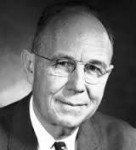
Harold Edgerton
American, 1903-1990
Jackie Jumps a Bench, 1938
gelatin silver print
7 1/2 x 9 1/2"
SBMA, Gift of the Harold and Esther Edgerton Foundation
1996.18.19

Harold Edgerton - undated photo
"Work hard. Tell everyone everything you know. Close a deal with a handshake. Have fun!" - Harold Edgerton
COMMENTS
Harold Eugene Edgerton, the first of Frank and Mary Edgerton’s three children, was born in Fremont, Nebraska, on April 6, 1903. Motors and machines of all sorts fascinated young Harold and he enjoyed taking apart broken things, figuring out how they worked, and fixing them.
Harold became interested in photography through his uncle, Ralph Edgerton, a studio photographer. Uncle Ralph taught Harold how to take, develop, and print pictures.
At MIT Doc studied the problems of synchronous motors, in which the speed of the motor is the same as the frequency of the electric current running it. He was most interested in what happened when a sudden change, like the surge caused by lightning striking the power lines, reached the motor. But parts of the motor spun so fast that his eye could not see what was happening. Doc noticed that a tube he was using to send power surges to the motor flashed brightly as the power peaked. When the flash of the light synchronized with the motor’s turning parts, it made them look like they were standing still. Then they could be analyzed!
In 1931, he earned his PhD.; his doctoral dissertation included a high-speed motion picture of a motor in motion, made with a mercury-arc stroboscope.
From 1931 onwards, Edgerton developed and improved strobes and used them to freeze objects in motion so that they could be captured on film by a camera. In the same year he developed techniques to use the strobe for ultra-high-speed movies. Adjustments and improvements to stroboscopic technologies continued throughout his career.
Edgerton published the first of his many articles in National Geographic magazine in 1947 entitled, "Hummingbirds in Action." The article contained high-speed photographs that illustrated for the first time the wing movements and flight patterns of these tiny birds. During the 1940s and 1950s, Edgerton often transported his heavy strobes from MIT to Boston Garden events, where he used one of the early Kodak color films at the rodeo, 1947.
- The Edgerton Digital Collections project, Massachusetts Institute of Technology
http://edgerton-digital-collections.org/
